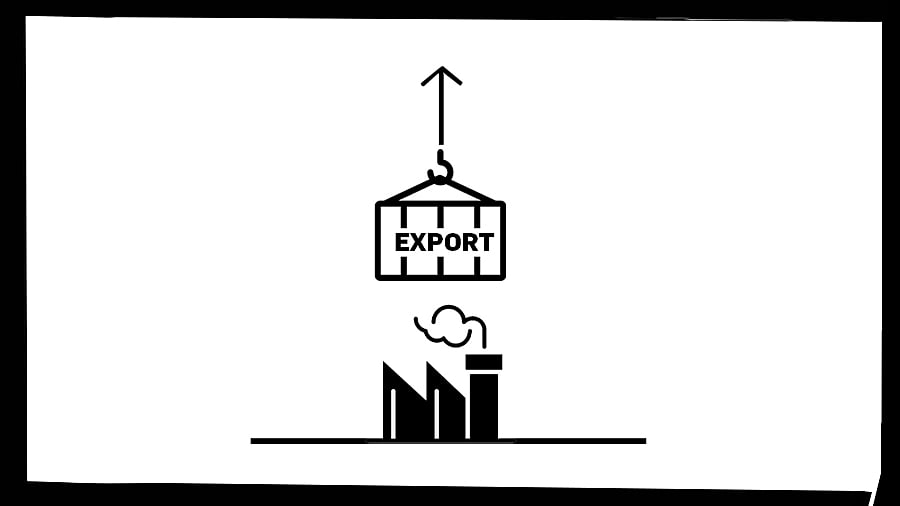
India is projected to contribute around 6% to the growth of global trade, according to the ‘DHL Trade Atlas 2025’ report, released by German logistics giant DHL in collaboration with the Stern School of Business. While the country’s expanding role in international trade brought significant economic benefits, the increasing dominance of pollution-intensive products in its export portfolio is raising serious environmental concerns. Inconsistent and weak enforcement of environmental laws and industry exemptions further challenge the balance between growth and sustainability. Without stricter policies and cleaner production methods, India’s trade success could come at a significant ecological cost.
India’s exports of pollution-intensive goods have surged since trade liberalisation in 1991. In 2023, these products accounted for 54% of total merchandise exports, valued at $231.48 billion. Their annual growth rate of 12.5% outpaced the overall export growth of 11%, increasing their share in India’s total exports from 36% in 1991 to 54% in 2023.
India’s global export share stood at 2% in 2023, but for pollution-intensive goods, it was nearly 3%. The growth in exports of these products outpaced that in imports, reflecting India’s increasing comparative advantage in these sectors. Petroleum and coal products dominated, contributing 38% of pollution-intensive exports. Along with non-metallic minerals, chemicals, pharmaceuticals, and automobiles, they comprised 84% of India’s pollution-intensive exports. Petroleum and coal products registered the highest growth rate of 20% during 1991-2023. Exports of non-ferrous metals, pulp and paper, automobiles, and pharmaceuticals also witnessed sharp growth in this period.
Pollution-intensive industries are also significant beneficiaries of FDI. Between April 2000 and December 2024, industrial sectors which are highly pollution-intensive attracted FDI of $149.26 billion, which was approximately 21% of the total FDI inflows to India. Automobiles, drugs and pharmaceuticals and chemicals sectors received the highest investment. Most of these sectors have permission for 100% FDI under automatic route. While this has bolstered industrial growth, concerns remain about technology transfer and the environmental impact of such investments.
The environmental toll of this growth cannot be ignored. Industrial activities tied to pollution-intensive exports contribute substantially to greenhouse gas emissions and hazardous waste production. Between 1991 and 2021, emissions from energy and industrial processes in India increased from 699 MtCO2e to 2606 MtCO2e, making up 76% of total emissions from India. GHG emission from the manufacturing/construction sector witnessed a five-fold increase in this period, from 155 MtCO2e to 568 MtCO2e, contributing about 23% of the total energy-related emissions. Industries such as chemicals and pharmaceuticals contribute significantly to hazardous waste production, posing risks to ecosystems and public health. The pharmaceutical sector significantly impacts the environment by polluting water and soil with hazardous waste, threatening biodiversity and public health. Manufacturing of cement is extremely dirty due to emissions of dangerous air pollutants and dust, posing significant health risks.
The policy landscape
India’s policy landscape reflects a fragmented approach to balancing trade and environmental priorities. Despite various environmental laws and policies, their enforcement remains weak, and industry exemptions exacerbate the problem. For instance, while national policies like the Environmental Protection Act (1986) and the National Environment Policy (2006) aim to promote sustainable development, their implementation often falls short. Compliance to the existing environmental laws is not satisfactory.
Export-Import policies have sporadically addressed environmental concerns. For example, the restrictions on mining exports were implemented in 2010 to curb illegal activities, only to be relaxed later under specific conditions. Similarly, the Draft Environment Impact Assessment Notification of 2020 has faced backlash for potentially diluting environmental standards. The disconnect between trade and environmental policies undermines the efforts to achieve sustainable growth in the long run.
Each pollution-intensive sector presents unique challenges. The iron and steel industry faces high production costs and limited access to advanced technologies. The pharmaceutical sector struggles with its supply chain inefficiencies, while the chemicals industry contends with raw material costs and regulatory hurdles. The mining sector, despite its potential, suffers from illegal practices, tribal conflicts, and underutilisation of resources. Machinery and electrical equipment manufacturers grapple with competition from cheaper imports and limited domestic innovation. Cement industry faces significant challenges in terms of high costs, scalability, and infrastructure bottlenecks.
India’s trade in pollution-intensive products presents both opportunities and challenges. These industries contribute significantly to GDP, employment, and FDI inflows, but pose substantial environmental risks that threaten long-term sustainability. Thus, it underscores the complex interplay between economic growth and environmental sustainability. While the country has made significant strides in industrial development, the associated environmental costs demand urgent attention. As India navigates its economic ambitions, striking a balance between industrial expansion and ecological preservation will be pivotal for its future.
To navigate this complex landscape, India must adopt a multi-faceted approach. Embracing cleaner technologies can help mitigate environmental damage. Strengthening regulatory frameworks and ensuring their effective implementation can address governance issues that hinder sustainability efforts. Aligning trade and environmental policies to ensure sustainable growth is critical. For instance, stricter environmental standards should be complemented by support for industries to transition to cleaner production methods. Developing less-polluting industries and fostering innovation in green technologies can diversify India’s trade portfolio.
Engaging with international partners to adopt best practices and secure funding for green initiatives can accelerate India’s progress towards a sustainable economy. The road ahead may be challenging, but with strategic interventions, India can achieve its vision of growth that respects both people and the planet.
(Varadurga is an assistant professor at R V University; Malini is an associate professor at the Institute for Social and Economic Change)
Disclaimer: The views expressed above are the author's own. They do not necessarily reflect the views of DH.